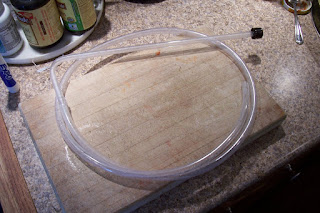Hello and welcome to my wine making post.
One day about 6 months ago I got the crazy idea in my head to start making wine, I don't know where it came from or why, but the feeling was strong and since I am a taurus there was no stopping me.
I did my research, gathered the proper tools, and found a recipe that looked easy below is the recipe/guide line that I used for my first batch. I say guide line because the recipes can not be followed to the letter because different climates produce different sugar contents in the fruit you are using.
I happen to have a wine and beer making shop 3 blocks from my house so it is easy if I need any last minute items.
the first day is the most exciting as you get to mix all the ingredients and sugar and water and chemicals,
RED RASPBERRY WINE
- 3-4 lbs fresh red raspberries
- 2-1/2 lbs finely granulated sugar
- 1/2 tsp acid blend
- 1/2 tsp pectic enzyme
- 1/8 tsp grape tannin
- 7-1/2 pints water(8pts = 1 gal)
- 1 tsp yeast nutrient
- 1 crushed Campden tablet
- wine yeast
Pick only ripe berries. mine were picked and frozen prior to using for wine. Combine water and sugar and put on to boil, stirring occasionally. Wash and de-stem berries. Put in nylon straining bag, tie, put in bottom of primary, and crush berries in bag. Pour boiling sugar-water over berries to set the color and extract the flavorful juice. Add acid blend, tannin and yeast nutrient. Allow to cool to 70 degrees F (about 4 hours or so). and add crushed Campden tablet. Cover primary with plastic wrap secured with a large rubber band. Add pectic enzyme after 12 hours and wine yeast after additional 12 hours, resecuring plastic wrap each time. Stir daily for a week, replacing plastic wrap if it looks like it needs it. Remove nylon bag and allow to drip drain about an hour, keeping primary covered as before. Do not squeeze bag. Return drippings to primary Continue fermentation in primary another week, stirring daily. Rack to secondary, top up with water and fit airlock. Use a dark secondary or wrap with brown paper (from paper bag) to preserve color. Ferment additional 2 months, then rack into clean secondary. Refit airlock and rack after additional 2 months. Wait another 2 months, rack again and bottle into dark glass. Drink after one year. This is an excellent dry wine, but don't rush it! You must ferment the full 6 months and age another year. Serve chilled.
DAY 1
I followed the recipe to the letter, I know I said not to but this was my first batch, adding all the ingredients as specified, However I did not account for the amount of time it takes for 1 gal of water to cool to 70 degrees after boiling, I mixed all the ingredients added to boiling water then sat back and let the magic happen unfortunately I started the wine later at night and after 2 hours of waiting the must was still too hot to add the campden tablet it was getting very late so I decided to use my sink to put the primary in and fill the sink with cold water while stirring the liquid, this cooled it down much faster, I don't know if it will make a difference because the boiling water is used to melt down the sugar and set the color of the raspberries, I think it will be fine, I added the campden once cooled and covered and went to bed.
DAY 2
12 hours after adding the campden tablet , I added the pectic enzyme. 12 hours later or 24 hours after the campden tablet, I added the best part about wine, the yeast, the yeast turns the sugar into alcohol. I started with a specific gravity of 1.100 so it should yield around 13% alcohol,
Days 3 and 4 are the same
The Must is very fizzy, kind of like soda in a glass, but that means its working, my bucket is in my dining room which is attached to the kitchen. It stays about 70-75 degrees in there which I have read is the best for primary fermentation, once it gets racked into the secondary (glass carboy) then it is best at 60-65 degrees. The whole place smells like yeasty and fruity, the airlock is bubbling pretty good and the directions at this point are simple:
1. stir
2. replace cover and wait another 24 hours and repeat
3. when specific gravity gets to 1.040 then rack into secondary
keep coming back for more updates. thanks for looking.

 This is shot of the sediment that was left after I siphoned the wine into a clean jug aka racking.
This is shot of the sediment that was left after I siphoned the wine into a clean jug aka racking. Here is a shot of the 2 jugs, after I racked it, as you can see the bottle on the right is the sediment and the bottle on the left is the wine after I racked, you can see there is no sediment, yet. Before I rack again there will be a significant layer again.
Here is a shot of the 2 jugs, after I racked it, as you can see the bottle on the right is the sediment and the bottle on the left is the wine after I racked, you can see there is no sediment, yet. Before I rack again there will be a significant layer again.








